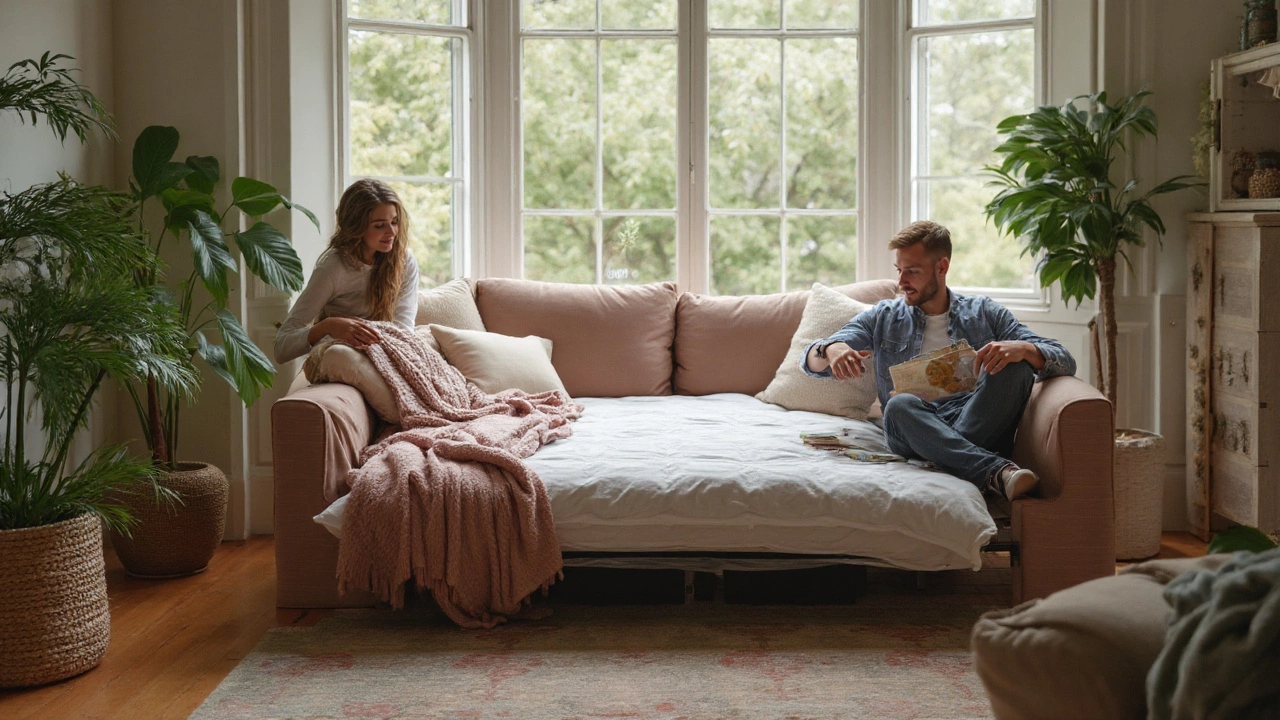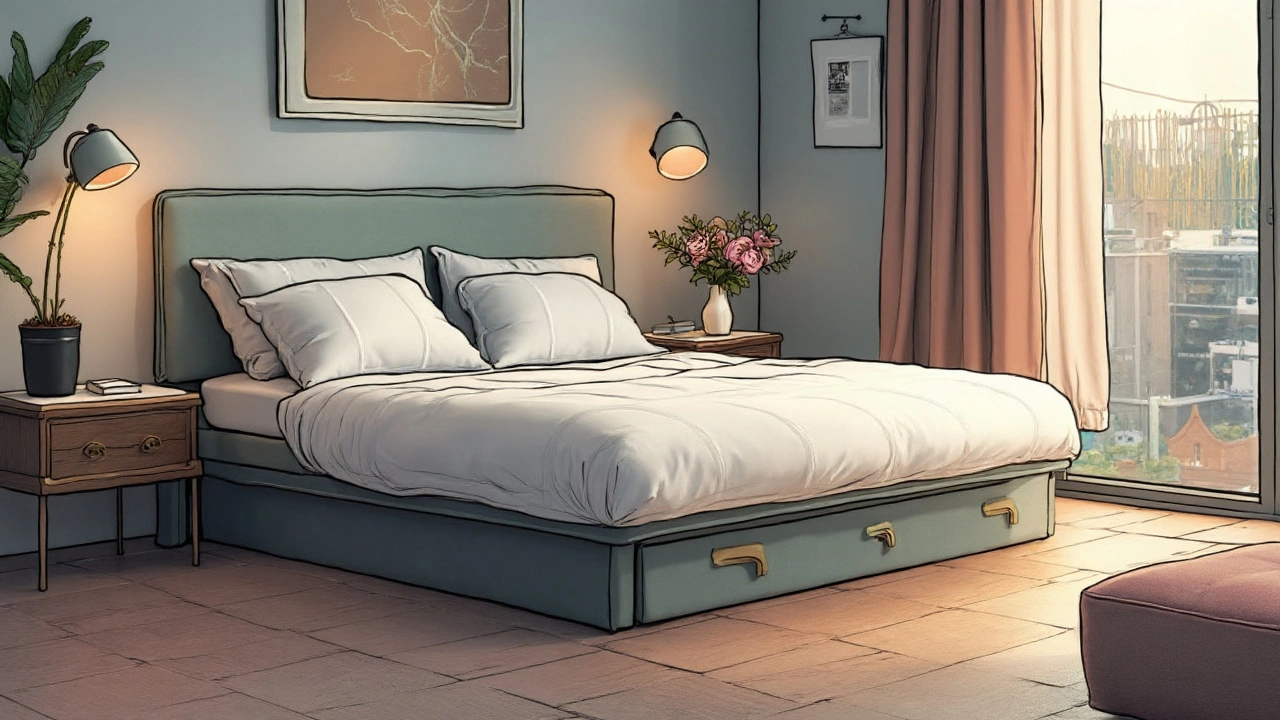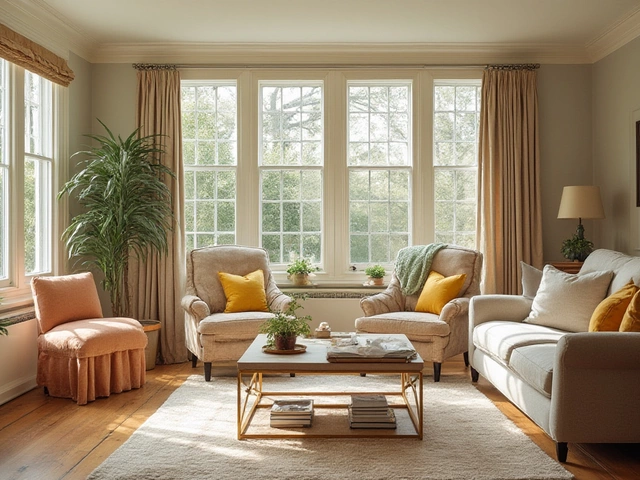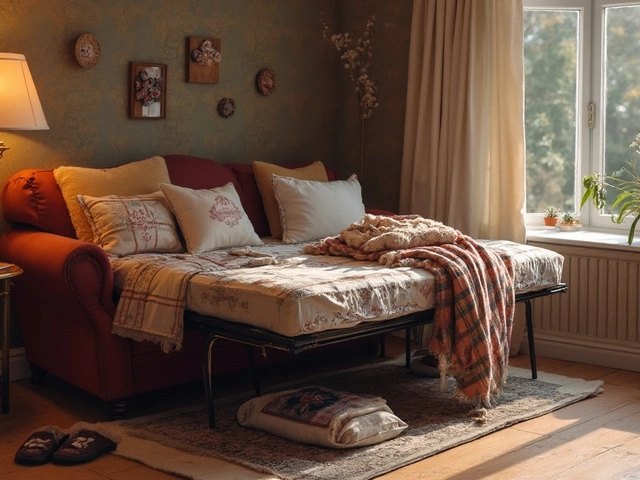 8
Aug,2025
8
Aug,2025
Ever slept on a sofa bed and woken up feeling like you lost a wrestling match to a sack of potatoes? You’re not alone. No one dreams of lumpy cushions or waking their guests with a creaky metal bar digging into their back. Yet, sofa beds keep popping up as the saviors of small apartments, studios, and guest rooms. The big question: how do you actually pick one that's comfortable and doesn’t turn into a source of regret — or back pain?
What Really Makes a Sofa Bed Comfortable?
Walk into any furniture store and you’ll see dozens of sofa beds claiming to be ‘the most comfortable’ or ‘the best for small spaces.’ But what’s behind these claims? The key is to dig into the real stuff that affects how you’ll sleep — and sit — on it.
First, pay attention to the mattress type. Some sofa beds have thin, springy mattresses that can’t compete with your own bed. Others have memory foam or even pocket springs. Here’s a quick breakdown of what you’ll commonly find:
- Innerspring mattresses: You’ll notice a lot of lower-cost sofa beds use these. They’re sturdy, but unless they’re at least 4.5 inches thick, you’ll probably feel the bars underneath. Not great for more than a night or two. Thicker ones give better support.
- Memory foam: These are softer and more modern. Memory foam molds to your body, smoothing out lumps. Just beware of cheap, thin options—they flatten out quickly.
- Pocket spring: You’ll see these in higher-end sofa beds, especially from European brands. Each spring moves independently. The result? Less partner-disturbance, less sag over time, better overall comfort.
The frame underneath matters too. The classic fold-out mechanism with a metal bar is notorious for killing backs. Look for updated systems: wooden slats, platform bases, or click-clack systems that spread your weight more evenly. IKEA tested their sofa beds for 25,000 open/close cycles; something similar from quality brands can last for a decade with regular use.
Another biggie: seat cushion depth. Sofas that look sleek in a showroom can be shallow or too firm, leading to uncomfortable sleep, especially if it’s your main bed. A good depth is between 21 and 24 inches — anything under 20 gets cramped fast.
The upholstery isn’t just about how it looks. Some materials like microfiber or polyester blends handle spills and pet claws better, while natural fibers like linen look luxe but stain easily. If your sofa bed gets a lot of action, prioritize removable covers and dark or busy patterns (they hide minor disasters from kids or snacks).
Armrests also make a surprising difference. Wide, flat arms give you space to perch or rest a laptop; narrow ones look modern but can feel flimsy when you brace yourself getting up. Little details like hidden storage under the seat, charging ports, or even a fold-out table are starting to pop up, making modern sofa beds as smart as they are comfy.

How to Test a Sofa Bed Before You Buy
Here’s the truth: you can’t judge a sofa bed just by sitting on it for two minutes. If possible, actually unfold it in the store. Lie down. Roll over. If there’s another person with you, have them lie down as well — see if there’s enough space and if you both get an even surface. Sleeping shoulder-to-shoulder on a narrow, saggy bed is a nightmare waiting to happen.
If you’re shopping online (and let’s face it, most of us do), check detailed reviews. Real photos from buyers — stains and all — tell you way more than studio shots. Look for consistent feedback about the mattress sagging or the mechanism sticking; more than three similar complaints should be a red flag. Trusted retailers like John Lewis and Wayfair often include close-ups, cross-sections, or setup videos. Don’t just trust the rating — dig into the worst-case scenarios in the reviews.
Don’t skip the delivery details. Sofa beds are hefty beasts. Some won’t fit through small stairways or doors (yes, people get stuck with sofa beds in hallways more than you’d think). Check the full measurements — folded and unfolded — and look up accounts from buyers who mention awkward setups, especially if you’re in an older home or apartment with tight turns.
If you want return peace-of-mind, ask specifically about trial periods. Some brands let you return a sofa bed within 30 or even 100 days if you hate it (usually for a pickup fee). Others only accept returns if the item’s still boxed up, which isn’t useful once you’ve unfolded it and slept on it. Read the fine print or you might get stuck reselling it on Facebook Marketplace.
If durability matters, get familiar with rub count numbers for upholstery (called the Martindale test). Good, hard-wearing fabrics have a count over 20,000. For families or heavy use, 40,000+ is gold. It’s a detail woven into the product tags of most major brands.
| Feature | What to Check |
|---|---|
| Mattress Thickness | At least 4.5 inches for regular comfort |
| Cushion Depth | 21-24 inches is ideal |
| Upholstery Durability | Martindale 20,000+ for regular, 40,000+ for heavy use |
| Frame Type | Look for slats or platform bases, avoid thin bars |
| Return Policy | 30+ day trial is safest |
Lastly, try to fold out and close the bed yourself – if it takes more muscle than a suitcase, or pinches your fingers, you’ll end up dreading the process. Some newer models even have gas assistance for easy lifting, like what you see on hatchback trunks.

Pitfalls and Hidden Perks: Picking the Right Sofa Bed for Your Life
Your lifestyle should drive your sofa bed choice. Are you throwing it in the spare room for surprise guests or sleeping on it every night? Occasional-use models like futons or click-clacks are fine for the odd sleepover, but lose shape quickly under daily use. If it doubles as your main bed, don’t cheap out — buy the best mattress you can afford, because your back (and mood) hinge on it every day.
Beds splitting into two halves can be a pro (two kids can sleep separately, less bed hogging), but often have a seam down the middle. If that bugs you, look for solid mattresses with no split. Chaises and sectional sofa beds give you more room to sprawl, but watch out: they usually need more floor space and may not line up with your layout. Measure twice, buy once.
For tiny spaces, you can’t beat a storage sofa bed. They hide pillows, linens, or winter clothes — a real two-birds-one-stone deal for city-dwellers. Newer models even come with under-seat drawers you can pull out easily. If you’re renting, modular sofa beds that break into a few lighter parts are lifesavers when moving (or getting into fifth-floor walk-ups).
Accessibility matters too. If you or your frequent guests have hip, knee, or back trouble, avoid low seat heights, skinny arms, and stiff mechanisms. Test if you can get up without grabbing something. Models with slightly higher legs (5-7 inches) make standing up smoother. For households with pets, skip anything labeled ‘chenille’ or ‘looped’ fabric unless you love vacuuming up fur.
Want a sleeper that can actually breathe? Latex foam and newer cooling gel memory foams handle sweaty nights better than classic foam. Some brands now use recycled plastics in their mattresses and eco-certified woods in their frames, which is worth it for the warm-fuzzy factor — if you’re into sustainability.
Kids or messy roommates? Zip-off, machine-wash covers are non-negotiable. Pet stains, spilled drinks, and takeout leave marks you can’t ignore. Replaceable slipcovers save money vs. tossing the whole sofa when disaster strikes.
If style’s your top concern, good news: there’s a legit sofa bed glow-up happening now. Designers are ditching bulky arms and generic, boxy shapes. Slim-leg, mid-century modern sofa beds and velvet finishes pop up on Instagram daily. Just balance label lust with practicality. Nobody wants a chic but rock-hard guest perch.
So, the next time someone shares a horror story of a grandparent waking up groaning after a night on the "guest" couch, you’ll know why it happened — and how to avoid it. Whether you need a napping zone, regular bed, or crash pad for visitors, choosing a sofa bed comes down to knowing your priorities, checking specs, and refusing to settle for less. Your back—and your guests—will thank you.




